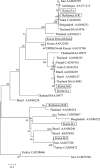Rapid dissemination of newly introduced Plasmodium vivax genotypes in South Korea
- PMID: 20207868
- PMCID: PMC2829904
- DOI: 10.4269/ajtmh.2010.09-0245
Rapid dissemination of newly introduced Plasmodium vivax genotypes in South Korea
Abstract
Reemerged Plasmodium vivax malaria in South Korea has not yet been eradicated despite continuous governmental efforts. It has rather become an endemic disease. Our study aimed to determine the genetic diversity in P. vivax merozoite surface protein-1 (PvMSP-1) and circumsporozoite protein (PvCSP) genes over an extended period after its reemergence to its current status. Sequence analysis of PvMSP-1 gene sequences from the 632 P. vivax isolates during 1996-2007 indicates that most isolates recently obtained were different from isolates obtained in the initial reemergence period. There was initially only one subtype (recombinant) present but its subtypes have varied since 2000; six MSP-1 subtypes were recently found. A similar variation was observed by CSP gene analysis; a new CSP subtype was found. Understanding genetic variation patterns of the parasite may help to analyze trends and assess extent of endemic malaria in South Korea.
Figures





Similar articles
-
Study of the genetic discrimination between imported and autochthonous cases of malaria in South Korea.J Travel Med. 2011 Jan-Feb;18(1):63-6. doi: 10.1111/j.1708-8305.2010.00473.x. Epub 2010 Dec 16. J Travel Med. 2011. PMID: 21199147
-
Dynamic changes of Plasmodium vivax population structure in South Korea.Infect Genet Evol. 2016 Nov;45:90-94. doi: 10.1016/j.meegid.2016.08.023. Epub 2016 Aug 22. Infect Genet Evol. 2016. PMID: 27562334
-
Genetic characterization of Plasmodium vivax isolates from Pakistan using circumsporozoite protein (pvcsp) and merozoite surface protein-1 (pvmsp-1) genes as genetic markers.Malar J. 2021 Feb 25;20(1):112. doi: 10.1186/s12936-021-03654-w. Malar J. 2021. PMID: 33632220 Free PMC article.
-
Genetic characteristics of polymorphic antigenic markers among Korean isolates of Plasmodium vivax.Korean J Parasitol. 2009 Oct;47 Suppl(Suppl):S51-8. doi: 10.3347/kjp.2009.47.S.S51. Korean J Parasitol. 2009. PMID: 19885335 Free PMC article. Review.
-
Genetic Diversity of Plasmodium vivax Causing Epidemic Malaria in the Republic of Korea.Korean J Parasitol. 2018 Dec;56(6):545-552. doi: 10.3347/kjp.2018.56.6.545. Epub 2018 Dec 31. Korean J Parasitol. 2018. PMID: 30630274 Free PMC article. Review.
Cited by
-
Genetic polymorphism and natural selection in the C-terminal 42 kDa region of merozoite surface protein-1 among Plasmodium vivax Korean isolates.Malar J. 2012 Jun 18;11:206. doi: 10.1186/1475-2875-11-206. Malar J. 2012. PMID: 22709605 Free PMC article.
-
The unique distribution of the Plasmodium vivax merozoite surface protein 1 in parasite isolates with short and long latent periods from the Republic of Korea.Malar J. 2015 Aug 5;14:299. doi: 10.1186/s12936-015-0803-3. Malar J. 2015. PMID: 26242878 Free PMC article.
-
Limited polymorphism of the Plasmodium vivax merozoite surface protein 1 gene in isolates from Turkey.Am J Trop Med Hyg. 2010 Dec;83(6):1230-7. doi: 10.4269/ajtmh.2010.10-0353. Am J Trop Med Hyg. 2010. PMID: 21118926 Free PMC article.
-
Distribution of Antibodies Specific to the 19-kDa and 33-kDa Fragments of Plasmodium vivax Merozoite Surface Protein 1 in Two Pathogenic Strains Infecting Korean Vivax Malaria Patients.Osong Public Health Res Perspect. 2016 Aug;7(4):213-9. doi: 10.1016/j.phrp.2016.05.006. Epub 2016 Jun 25. Osong Public Health Res Perspect. 2016. PMID: 27635370 Free PMC article.
-
Global genetic diversity of the Plasmodium vivax transmission-blocking vaccine candidate Pvs48/45.Malar J. 2016 Apr 12;15:202. doi: 10.1186/s12936-016-1263-0. Malar J. 2016. PMID: 27067024 Free PMC article.
References
-
- Mendis K, Sina BJ, Marchesini P, Carter R. The neglected burden of Plasmodium vivax malaria. Am J Trop Med Hyg. 2001;64:97–106. - PubMed
-
- Chai IH. Occurrence of tertian malaria in a male patient who has never been abroad. Korean J Parasitol. 1994;32:195–200. - PubMed
-
- Leclerc MC, Gauthier C, Villegas L, Urdaneta L. Genetic diversity of merozoite surface protein-1 gene of Plasmodium vivax isolates in mining villages of Venezuela (Bolivar State) Acta Trop. 2005;95:26–32. - PubMed
Publication types
MeSH terms
Substances
LinkOut - more resources
Full Text Sources
Research Materials

